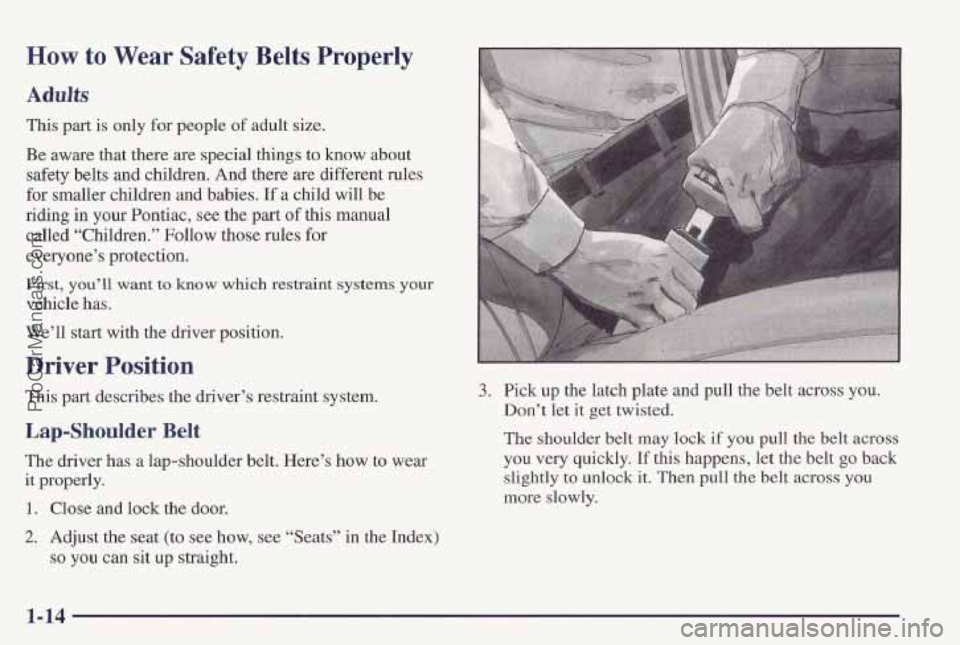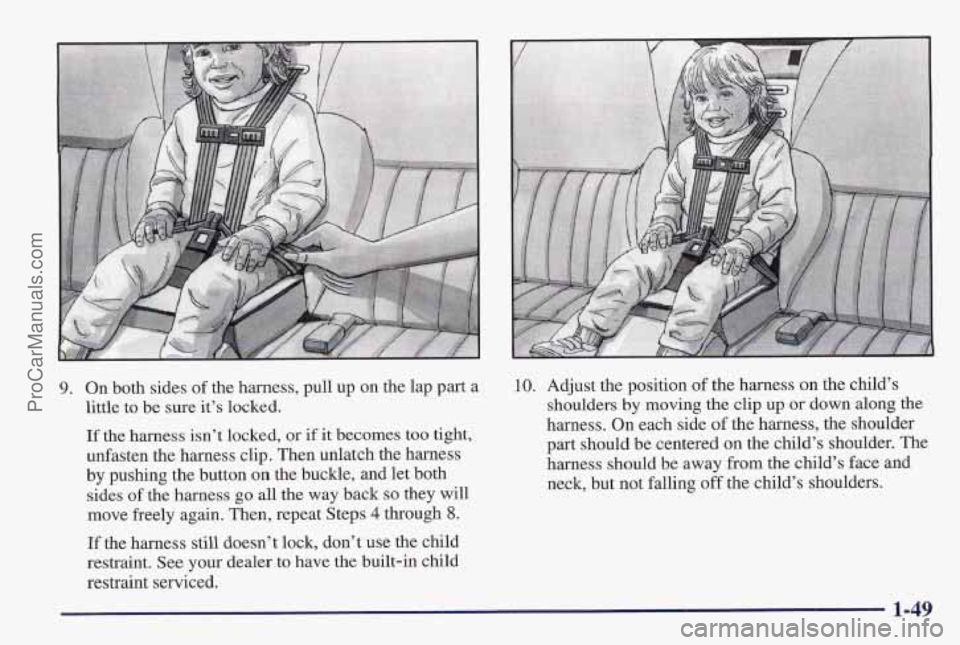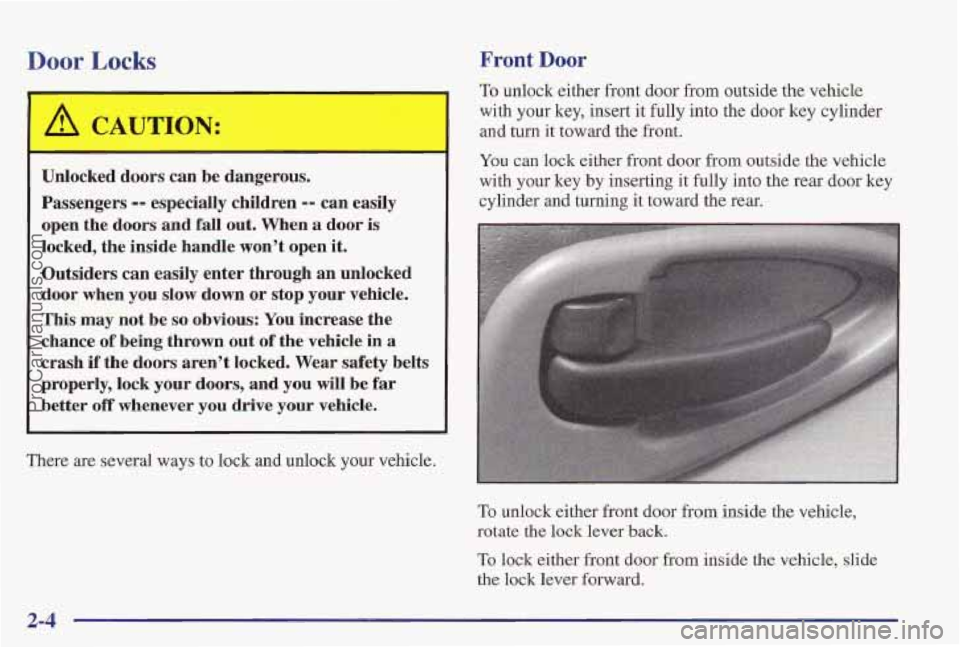1997 PONTIAC PONTIAC child lock
[x] Cancel search: child lockPage 22 of 419

How to Wear Safety Belts Properly
Adults
This part is only for people of adult size.
Be aware that there
are special things to know about
safety belts and children. And there are different rules
for smaller children and babies. If a child will be
riding in your Pontiae, see the part of this manual
called “Children.” Follow those rules
for
everyone’s protection.
First, you’ll want to know which restraint systems your
vehicle has.
We’ll start with the driver position.
Driver Position
This part describes the driver’s restraint system.
Lap-Shoulder Belt
The driver has a lap-shoulder belt. Here’s how to wear
it properly.
I. Close and lock the door.
2. Adjust the seat (to see how, see “Seats” in the Index)
so you can sit up straight.
3. Pick up the latch plate and pull the belt across you.
Don’t let it get twisted.
The shoulder belt may
lock if you pull the belt across
you very quickly. If this happens, let the belt
go back
slightly
to unlock it. Then pull the belt across you
more slowly.
1-14
ProCarManuals.com
Page 57 of 419

9. On both sides of the harness, pull up on the lap part a
little to be sure it’s locked.
If the harness isn’t locked, or if it becomes too tight,
unfasten the harness clip. Then unlatch the harness
by pushing the button
on the buckle, and let both
sides of the harness go all the way back
so they will
move freely again. Then, repeat Steps
4 through 8.
If the harness still doesn’t lock, don’t use the child
restraint. See your dealer to have the built-in child
restraint serviced. 10.
Adjust the position
of the harness on the child’s
shoulders by moving the clip up
or down along the
harness. On each side of the harness, the shoulder
part should be centered on the child’s shoulder. The
harness should be away from
the child’s face and
neck, but not falling
off the child’s shoulders.
1-49
ProCarManuals.com
Page 63 of 419

5. Pull the rest of the shoulder belt all the way out of
the retractor to set the lock.
6. To tighten the belt, feed the shoulder belt back
into the retractor while you push down
on the
child restraint.
7. Push and pull the child restraint in different
directions to be sure it is secure.
To remove the child restraint, just unbuckle the vehicle's
safety
belt and let it go back all the way. The safety belt
will move freely again and be ready to work for an adult
or larger child passenger.
1-55
ProCarManuals.com
Page 78 of 419

Door Locks Front Door
Unlocked doors can be dangerous.
Passengers
-- especially children -- can easily
open the doors and fall
out. When a door is
locked, the inside handle won’t open
it.
Outsiders can easily enter through an unlocked
door when you slow down or stop your vehicle.
This may not
be so obvious: You increase the
chance of being thrown
out of the vehicle in a
crash if the doors aren’t locked. Wear safety belt:
properly, lock your
doors, and you will be far
better off whenever you drive your vehicle.
To unlock either front door from outside the vehicle
with your key, insert it fully into the door key cylinder
and turn it toward the front.
You can lock either front door from outside the vehicle
with your key by inserting it fully into the rear door key
cylinder and turning it toward the rear.
There are several ways to lock and unlock your vehicle.
To unlock either front door from inside the vehicle,
rotate the lock
lever back.
To lock either front door from inside the vehicle, slide
the
lock lever forward.
2-4
ProCarManuals.com
Page 80 of 419

Last Door Closed Locking
The Last Door Closed Locking makes it more
convenient €or you to use your power door lo’cks to lock
all doors when leaving your vehicle. When any door
is
open, the first time you attempt to lock the doors using
the power
door lock switch or key chain transmitter will
result in three chimes to signal that Last
Door Closed
Locking is being used. All doors can be opened for any
reason for five seconds from the time the last door has
been closed. Five seconds after the last door is closed,
all doors will lock. You can lock the doors immediately
by using the power door lock switch or the key chain
transmitter
to lock again.
The Last Door Closed
Locking feature will not
occur and d’oors will not
be locked as a result of this
feature when
the ignition switch is in the RUN or
ACCESSORY position. The Last Door Closed Locking
feature
is not enabled from the factory.
Automatic Door Locks
I
Unlocked doors can be dangerous.
Passengers -- especially children -- can easily
open the doors and fall out. When
a door is
locked, the inside handle won’t open
it.
Outsiders can easily enter through an unlocked
door when you slow down or stop your vehicle.
This
may not be so obvious: You increase the
chance
of being thrown out of the vehicle in a
crash
if the doors aren’t locked. Wear safety belts
properly, lock your doors, and you will
be far
better off whenever you drive your vehicle.
To turn the Last Door Closed Locking feature on or off,
see “Locks and Lighting Choices” in the Index. All of the
doors will lock automatically when you move
your shift lever
out of PARK (P). All doors will. unl’ock
automatically when the ignition
is turned off while the
shift lever
is in PARK (P). If you prefer to have your
doors unlocked automatically at any time, see “Locks
and Lighting Choices” in the Index.
2-6
ProCarManuals.com
Page 120 of 419

To change the factory setting while in the programming
mode do the following:
1. Tun the interior lamps dial all the way to the right
and then back slightly
to the left.
2. Count the number of chimes you hear. The number
of chimes tells you which mode your vlehide is set
for. You change the mode by turning the interior
lamps dial all
the way to the right and then back
slightly
to the left.
3. Repeat step 2 until you hear the number of chimes
Mode 1: Both Off (The interior lamps will turn on OF off
at the same instant that a door is opened or closed).
Mode 2: Delayed Illumination Only (The interior lamps
will
stay on for about 25 seconds after all the doors are
closed, or until you lock the doors).
that matches the mode you want.
Mode 3: Exit Lighting Only (The interim lamps will
come on whenever you remwe
the key from the ignition
and stay on for about 25 seconds, or until you lock
the doors).
Mode 4: Both On (This combines modes 2 and 3).
Automatic Door Locks
A CAUTION:
Unlocked doors can be dangerous.
Passengers-especially children-can easily fall
out. When
a door is locked, the inside handle
won’t open it.
Outsiders can easily enter through an unlocked
door when you slow down or stop your vehicle.
This may
not be so obvious: You increase the
chance
of being thrown out of the vehicle in a
crash
if the doors aren’t locked, Wear safety belts
properly, lock your doors, and you will be far
better off whenever you drive your vehicle.
2-46
ProCarManuals.com
Page 206 of 419

If you need to reduce your speed as you approach a
curve, do it before you enter the curve, while your front
wheels are straight ahead.
Try to adjust your speed
so you can “drive” through the
curve. Maintain a reasonable, steady speed. Wait to
accelerate until you are out of the curve, and then
accelerate gently into
the straightaway.
Steering in Emergencies
There are times when steering can be more effective
than braking, For example, you come over a hill and
find a truck stopped in your lane, or a car suddenly pulls
out from nowhere, or a child darts out from betw,een
parked cars and stops right in front
of you. You can
avoid these problems by braking
-- if you can stop
in time. But sometimes you can’t; there isn’t room.
That’s the time for evasive action
-- steering around
the problem.
Your Pontiac can perform very well in emergencies like
these. First apply
your brakes. (See “Braking in
Emergencies” earlier in
this section.) It is better to
remove as much speed as you can from a possible
collision. Then steer around
the problem, to the left or
right depending
on the space available.
An emergency like this requires close attention and a
quick decision.
If you are holding the steering wheel at
the recommended 9 and 3 o’clock positions, you can
turn
it a full 180 degrees very quickly without removing
either hand. But you have to act fast, steer quickly, and
just as quickly straighten the wheel once you have
avoided the object.
The fact that such emergency situations are always
possible
is a good reason to practice defensive driving at
all times
and wear safety belts properly.
4-12
ProCarManuals.com
Page 384 of 419

At Least Twice a Year
Restraint System Check
Make sure the safety belt reminder light and all your
belts, buckles, latch plates, retractors and anchorages are
working properly, If
your vehicle has a built-in child
restraint, also periodically make sure the harness straps,
latch plates, buckle, clip, retractors and anchorages are
working properly. Look for any other
loose or damaged
safety belt and built-in child restraint system
parts. If
you see anything that might keep a safety belt or built-in
child restraint system from doing its
job, have it
repaired. Have any torn or frayed safety belts or harness
straps replaced.
Also look for any opened or broken air bag co’verings,
and have them repaired or replaced,
(The’ air bag system
does
not need regular maintenance.)
Wiper Blade Check
Inspect wiper blades for wear or cracking. Replace blade
inserts that appear worn or damaged or that streak or
miss areas oftle windshield. Also see “Wiper Blades,
Cleaning”
in the Index.
Automatic Tkansaxle Check
Check the transaxle fluid level; add if needed. See
“Automatic Transaxle” in
the Index. A fluid loss
may indicate a problem. Check the system and repair
if needed.
At Least Once a Year
Key Lock Cylinders Service
Lubricate the key lock cylinders with the lubricant
specified in
Part D,
Body Lubrication Service
Lubricate all hinges and latches, including those for the
hood, rear compartment, glove box door, console door
and any folding
seat hardware, Part D tells you what to
use. More frequent lubrication may be required when
#exposed
to a! corrosive environment.
7-40
ProCarManuals.com